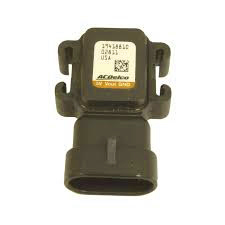Mercedes Tire Pressure Sensor Problems; By Sensor Guides
Tire pressure sensors are an essential safety feature in modern Mercedes cars. They are designed to monitor the air pressure in each tire and alert the driver if the pressure drops below a safe level. However, these sensors can encounter problems that affect their accuracy and reliability.
In this article, we will explore the common tire pressure sensor problems in Mercedes, their causes, and how to troubleshoot and prevent them.
Table of Contents
Understanding Mercedes Tire Pressure Sensors
Tire pressure sensors are electronic devices that measure the air pressure in each tire and send this information to the car’s computer system. Mercedes cars use two types of tire pressure sensors: direct and indirect sensors.
Direct sensors use a pressure sensor inside the tire to measure the air pressure. The sensor sends a signal to the car’s computer, which then displays the tire pressure readings on the dashboard. Direct sensors are more accurate and provide real-time data on tire pressure.
Indirect sensors, on the other hand, use the car’s anti-lock braking system to detect changes in tire circumference caused by pressure changes. The car’s computer compares the speed of each wheel and detects changes in the circumference of the tire. The system then alerts the driver if the tire pressure drops below a safe level.
Common Tire Pressure Sensor Problems in Mercedes:
- Low tire pressure warning light is on even when tires are properly inflated:
This is one of the most common problems with tire pressure sensors in Mercedes cars. The low tire pressure warning light comes on even when the tires are properly inflated. This can happen if the sensor is damaged, the battery is dead, or the sensor is not communicating properly with the car’s computer system.
- Incorrect tire pressure readings displayed on the dashboard:
Another common problem is incorrect tire pressure readings displayed on the dashboard. This can happen if the sensor is not calibrated correctly or if there is interference from other electronic devices in the car. In some cases, the readings may be delayed or incorrect, which can cause the driver to ignore the warning.
- Tire pressure sensor failure due to wear and tear or electrical issues:
Tire pressure sensors are prone to wear and tear over time. They can also fail due to electrical issues or battery failure. This can cause the sensor to stop working or send incorrect signals to the car’s computer system.
- Issues with the tire pressure sensor module or wiring:
Issues with the tire pressure sensor module or wiring can cause problems with the sensor readings. The module or wiring may become corroded or disconnected, which can cause the sensor to stop working or send incorrect signals to the car’s computer system.
Recommended tire pressure levels for Mercedes cars
| Car Model | Tire Size | Recommended Pressure |
| C-Class | 225/50R17 | 32 psi |
| E-Class | 245/45R18 | 32 psi |
| S-Class | 245/50R18 | 32 psi |
| GLE-Class | 255/50R19 | 36 psi |
| GLC-Class | 235/60R18 | 32 psi |
Troubleshooting Mercedes Tire Pressure Sensor Problems:
If the low tire pressure warning light comes on, the first step is to check the tire pressure manually using a tire pressure gauge. It is important to ensure that the tire pressure matches the recommended levels specified in the owner’s manual. If the pressure is correct, try resetting the tire pressure monitoring system in the car’s computer. The process varies depending on the car model and year, so it’s essential to check the owner’s manual for specific instructions.
If the problem persists, it may be necessary to replace the tire pressure sensors or the sensor module. Replacing the sensors can be an expensive process, so it’s essential to get an accurate diagnosis before proceeding.
Common problems and solutions for Mercedes tire pressure sensors
| Problem | Solution |
| Low tire pressure warning light is on even when tires are properly inflated | Check tire pressure manually, reset the tire pressure monitoring system, replace the tire pressure sensors or the sensor module |
| Incorrect tire pressure readings displayed on the dashboard | Check tire pressure manually, calibrate the sensor, replace the sensor module |
| Tire pressure sensor failure due to wear and tear or electrical issues | Replace the tire pressure sensors or the sensor module |
| Issues with the tire pressure sensor module or wiring | Inspect and clean the connections, replace the sensor module or wiring if necessary |
Preventing Tire Pressure Sensor Problems in Mercedes:
Regular tire maintenance is essential to prevent problems with tire pressure sensors. It’s important to check the tire pressure regularly and inflate the tires to the recommended levels specified in the owner’s manual. Mercedes recommends checking tire pressure at least once a month and before long trips.
Keeping the sensors clean and free of debris can also help to ensure accurate readings. Dirt, mud, and snow can accumulate on the sensors, causing them
to malfunction. Clean the sensors with a soft cloth regularly to prevent this.
Regular inspections and maintenance of the car’s electrical system can also prevent issues with the sensor module or wiring. Corroded or loose connections can cause the sensor to stop working or send incorrect signals to the car’s computer system. Regular inspections can help to detect and fix these issues before they cause problems.
Conclusion:
In conclusion, tire pressure sensors are an essential safety feature in modern Mercedes cars. However, they can encounter problems that affect their accuracy and reliability. The most common problems include the low tire pressure warning light being on even when tires are properly inflated, incorrect tire pressure readings displayed on the dashboard, tire pressure sensor failure due to wear and tear or electrical issues, and issues with the tire pressure sensor module or wiring.
If you encounter problems with your Mercedes tire pressure sensors, it’s important to troubleshoot and address them promptly. Regular tire maintenance, keeping the sensors clean and free of debris, and regular inspections and maintenance of the car’s electrical system can prevent these problems from occurring.
Remember, properly inflated tires not only improve the performance of your car but also increase your safety on the road. Don’t ignore tire pressure sensor problems, and always make sure to maintain your tires in the best possible condition.





